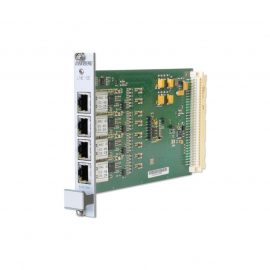Overview
As a cost effective alternative to the LANTIME M1000 standard model, the M1000S has all connectors and control elements on its front panel, allowing to mount it inside racks that are only accessible from one side. The M1000S provides the following slot types:
IMS-CLK: Up to two reference clock modules (redundant mode)
IMS-PSU:Up to two high efficiency redundant power supplies (AC and DC versions available)
IMS-CPU: Central processor module providing NTP / SNTP time synchronization and management and configuration interfaces
IMS-ESI: Input references for 2.048MHz, 2.048MBit/s and variable frequencies:
IMS-MRI: IRIG, 1PPS, 10MHz input module:
IMS-IO: A variety of output signals for all types of synchronization tasks: Pulses, frequencies, time codes, serial time messages) and of course more network interfaces (IEEE-1588, NTP/Management ports)
NTP Time Server for large Networks:
With up to 10,000 NTP requests per second, the system is able to provide time for hundreds and thousands of NTP clients. The LANTIME module supports the following protocols: IPv4, IPv6, NTP / SNTP (v2, v3, v4), HTTP (S), SSH, Telnet, SNMP (v1, v2, v3), FTP, SFTP, DHCP/DHCPv6. For each system, up to 99 logical network interfaces are available (99 IPv4 and 99 IPv6 addresses).
Scalable NTP Time Server System:
All modules are hot-plug capable and the modules can be configured via the central web interface (from the CPU module). Almost infinite number of combinations of input and output modules are available to meet almost any synchronization task. Because of simple extension by upgrading the system with new modules the scalability of the M3000 system is ensured.
Slots for Input Signals:
IMS-MRI:Standard reference inputs
IMS-ESI: Extended reference inputs
Both of these reference input interfaces may also be used as I / O slot.
The Active Cooling Module allows the installation of the M1000 safely within the temperature specification. The ACM is easily field-replaceable and allows for a hot-plug replacement without the need to power down the unit.






Leave a Reply